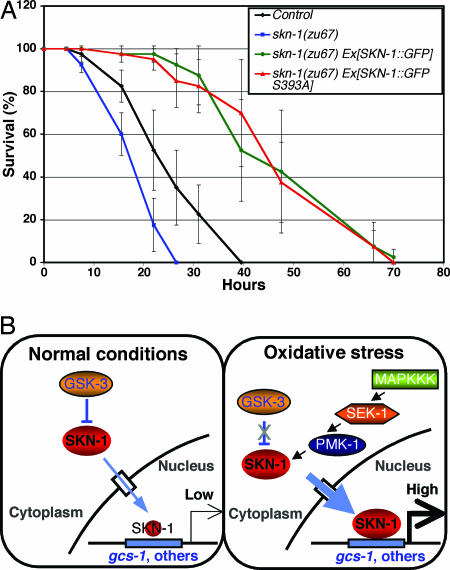Fig. 4.
SKN-1 protects against oxidative stress. (A) SKN-1::GFP overexpression confers oxidative stress resistance. Transgenically expressed WT and S393A forms of SKN-1::GFP comparably rescue the oxidative stress sensitivity of skn-1(zu67) mutants and provide additional protection against oxidative stress. All animals analyzed carry the rol-6 transgenic marker and were derived from worms that are heterozygous for the DnT1 balancer. Control thus refers to N2;rol-6 progeny that were derived from N2;rol-6;DnT1/+ animals. Individual worms were scored for survival at the times shown after they had been placed on nematode growth medium plates containing 6.2 mM t-butyl hydroperoxide. Under these stress conditions, SKN-1::GFP accumulated in intestinal nuclei and gcs-1::gfp expression was increased (data not shown). This representative experiment involved 40 worms in each group. Error bars indicate standard deviations. P values for skn-1(zu67), skn-1(zu67) Ex[SKN-1::GFP], and skn-1(zu67) Ex[SKN-1::GFP S393A] compared with control were 0.034, 0.007, and 0.009, respectively. (B) A model for regulation of SKN-1 in the intestine. Under normal conditions, SKN-1 is phosphorylated constitutively by GSK-3 and prevented from accumulating in the nucleus. This inhibition depends on the prior priming phosphorylation of SKN-1, which represents an additional negative signal (see Results and Discussion). SKN-1 target genes, represented by gcs-1, are then expressed at very low levels. Under oxidative stress conditions, p38 pathway signaling and PMK-1 phosphorylation of SKN-1 are dramatically increased (28). This signal counteracts inhibition of SKN-1 by GSK-3 and is independently required for SKN-1 to accumulate in nuclei at high levels and induce phase II gene expression. These phosphorylation events are arbitrarily shown as occurring in the cytoplasm. MAPKKK, MAPK kinase kinase.

